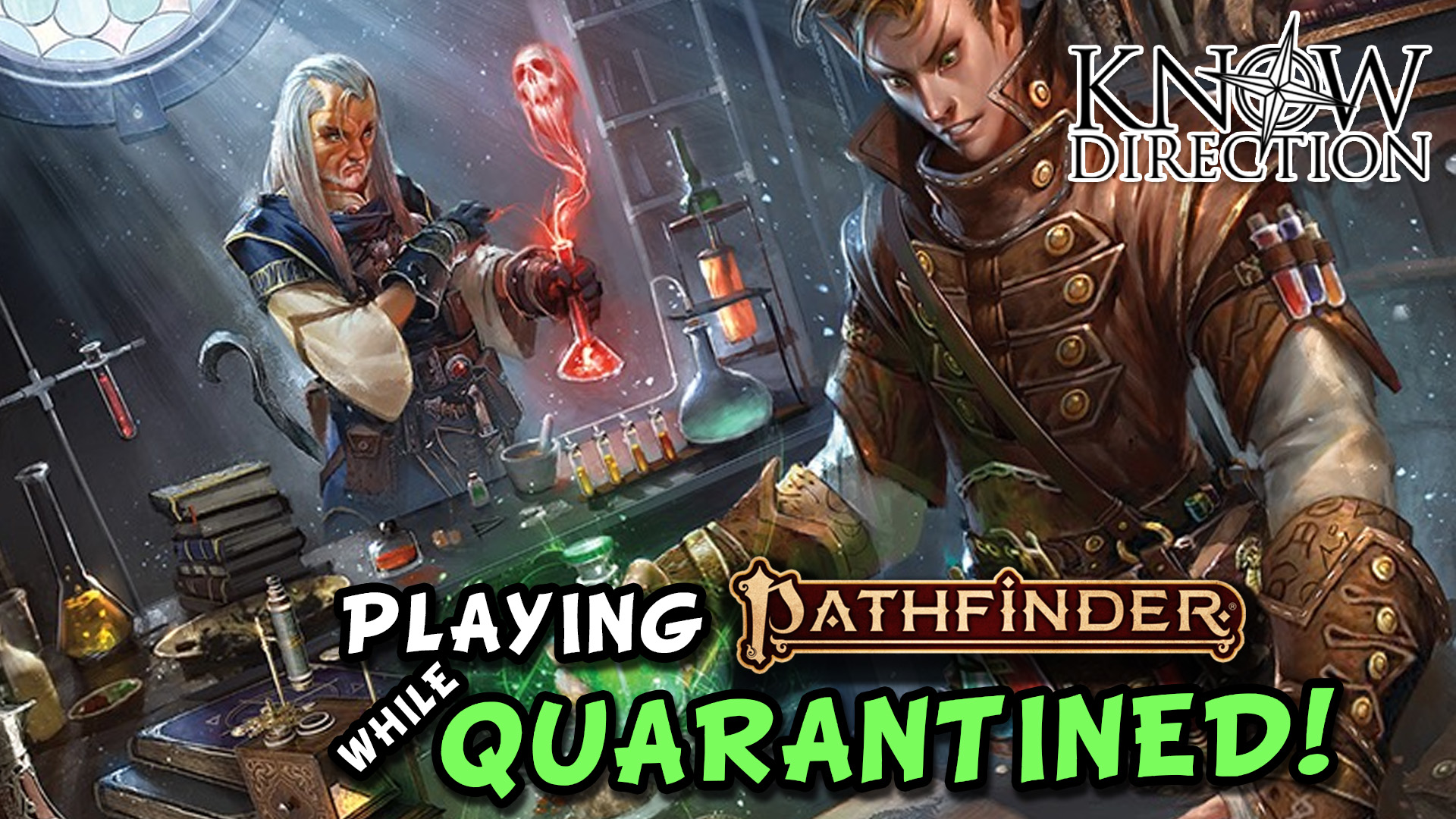Disclaimer: Disease can be a socially complex topic during our time of crisis, and including them in your game has the potential to make some of your players uncomfortable. You should discuss the role it plays in your campaigns during these uncertain times, and be prepared to replace them with other afflictions like curses using similar mechanics if players at your table are made uncomfortable by the topic. I am not a licensed health care practitioner and nothing in this article is intended as medical advice.
Wash your hands for 20 seconds and cough into your elbows, because this week we are looking at the mechanics for and roles played by diseases in Pathfinder Second Edition!
But first: I hope everyone is staying safe. Know Direction’s own Monica Marlow wrote an insightful column on the global pandemic here. (Seriously, read this.) And you can find plenty of information as to how to enjoy yourself playing Pathfinder & Starfinder online here. I have been frequenting the Know Direction and Pathfinder Society Online Region Discords, where I’m sure you can find games during your quarantine.
Disease is an often overlooked mechanic in the Pathfinder Roleplaying Game. In First Edition, players had a cadre of options to gain resistance or even outright immunity to disease, making it a mixed bag for inclusion in both monster stat blocks and adventures. The most memorable adventure I’ve played dealing with disease needed a special template applied to the diseases that let them bypass all immunities and magical treatments, which just highlighted how easy they were to deal with in that edition of the game.
Those days are over.
Diseases are now a potent arsenal in any campaign, and a powerful storytelling tool to boot. You can easily make it the theme of your entire campaign, perhaps taking some inspiration from a certain 1st Edition Adventure Path or Season 9 Pathfinder Society scenario. They can devastate an unprepared party, adding an element of realism to a group more prepared to deal with scarlet walkers than scarlet fever. Today I want to look over how diseases work, take a look at a few in action, and give our players some tools they can use to fight the Pallid Princess.
Disease Basics:
Diseases are a type of affliction. They are usually used as part of a creature’s attack, special qualities, or spell, but can function as a simple hazard to make adjoining encounters more challenging or even as part of an encounter (conferring additional XP based on the disease’s level). Upon exposure, a character has to roll a saving throw or is afflicted with the disease. After the onset period (or immediately, if none), a character who failed their initial saving throw advances to stage 1 of the affliction (or stage 2 on a critical failure).
At the end of each stage, you receive a new saving throw. If you fail, you advance 1 stage (2 on a critical failure). If you succeed, you reduce the stage by 1 (2 on a critical success). The affliction ends when you reach the maximum duration or manage to reduce the affliction below stage 1. Even if you reach the highest stage, you will continue the effects of that high stage until you roll successes on those saving throws. The affliction ends once it reaches its maximum duration.
Special Rules:
Secret: In addition to providing a plethora of useful diseases, the Gamemastery Guide suggests potentially making saving throws against afflictions secret rolls, especially in horror campaigns. Our inability to see a disease is only made more frightening by the fact we often don’t know if we are infected!
Sickened: If you are sickened due to a disease, you cannot eat or drink during encounter mode. This can affect the use of many items, including potions and antiplague! Most diseases don’t let you reduce your sickened value, as described in the entry for that disease. Some diseases let you reduce your sickened value to sickened 1, and other diseases do not let you reduce your sickened value at all, Some GMs may rule that snake oil can help, but you should remember that while remedying symptoms can help your wellbeing by reducing stress in your daily life, it should not replace the care of a medical professional!
Virulent: If a disease has the virulent trait, you must succeed at two consecutive saves to reduce its stage by 1. And a critical success reduces its stage by only 1 instead of by 2. Especially virulent diseases are hard to get rid of, and you can feel better for days but suddenly grow sicker if you exert yourself again.
Example: Bubonic Plague
Let’s go ahead and use perhaps the most infamous pandemic as an example to understand how diseases work. Follow me, if you will, to read the stat block on the bubonic plague.
Exposure: Each time a player is exposed to the disease, they need to roll a DC 17 Fortitude Save. On a success or critical success, they are not afflicted. On a failure, they advance to stage 1. On a critical failure, they advance to stage 3.
Stage 1: After 1 day of being fatigued, the player gets another save. If they succeed, they are cured. If they fail, they advance to stage 2. If they get a critical failure, they advance to stage 3.
Stage 2: After 1 day of being fatigued and enfeebled 2, the player gets another save. If they get a critical success, they are cured. If they succeed, they revert to stage 1. If they fail or get a critical failure, they advance to stage 3.
Stage 3: After 1 day of being enfeebled 3, fatigued, and taking 1d6 persistent bleed damage every 1d20 minutes, the player gets another save. If they get a critical success, they revert to Stage 1. If they get a success, they revert to stage 2. If they get a failure or critical failure, they stay on stage 3 (since there is no stage 4).
This particular disease has no maximum duration, so a character with the disease will either have to save against it, get it cured magically, or use the downtime activity Treat Disease. There are no rules set in stone for how diseases spread, except for those conferred by specific hazards, spells, and monsters. Treat each disease based on the needs of your story, using the symptoms and onset time to construct a particular way in which the affliction spreads. Rest, hydration, and social distancing are key in curbing the spread of a pandemic. Depending on the nature of the diseases used, a GM might even penalize saving throws for characters who refuse to take time off or are taking damage from starvation and thirst. This can become a particular problem if the disease is suspected to be water- or foodborne. You might also want to limit certain options that can too easily cure disease to be uncommon or rare, perhaps representing the depleted resources of a plague-stricken community.
Fighting Disease
Various feats can help a character in a disease-heavy campaign, including fast recovery, robust recovery, and ward medic. Lizardfolk and goblins get options to help fight against disease. Champions are no longer immune to disease, but can take divine health and affliction mercy. Monks meanwhile get the potent wholeness of body focus spell. And Clerics with healing font can take channeled succor to try to counteract a disease. Characters with the indulgence domain can try to help a disease take its course.
Spells like restoration can help treat a condition like enfeebled, but you will still have the disease and regain the condition the next time you enter a stage of the disease that inflicts enfeebled.
Antiplague is most adventurer’s go-to solution for disease. remove disease is a great scroll to carry around. Snake oil can help, but I recommend asking your GM if soap can give a mechanical benefit to avoiding the hazard in the first place. Soap has the incredible ability to break apart the cells that make up the bacteria and viruses that cause disease, letting you wash away the remains of the nasties with water once you properly lather up the exposed body part. Of course that’s less useful in combat, especially given how rare running water can be in a fantasy setting. If you have no water, alcohol (90%) or prestidigitation can help clean affected surfaces. Note that alcohol has its own disease, and drinking it can lower your immune system.
You can even ask your GM about using your exploration activity to try to avoid contamination if a particularly virulent disease is spreading in your campaign!
Social Distancing
[Exploration]
You keep your distance from others to help lessen the spread of a disease, holding your breath when you come too close to another creature, avoiding alcohol, coughing into your elbow, and avoiding touching your face. You get a +1 circumstance bonus to Fortitude saves against contracting new diseases. Creatures around you are unlikely to contract a disease as long as you can successfully continue this exploration activity. Spread of disease due to accidental contact (including during Encounter mode), can be mitigated with 10 minutes of washing as part of the Social Distancing activity.
Special: You may choose this exploration activity even if you are fatigued due to a disease.






